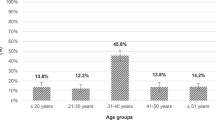Abstract
A detailed general information questionnaire was used to elicit informationfrom 400 households in two urban and two rural communities each in Anambraand Enugu states in Nigeria. The results showed that over 85% of the samplepopulation in both states were familiar with fermentation as a food processing method. Only 1.01% was familiar with germination as a processingstep in traditional food preparation. Preference (15–54%), cost (4–16%),mother's advice (2–14%) and medical advice (4–5%) in the 4 locationslargely influenced choice of foods. The amount of money spent on complementary foods in surveyed families ranged from less than N 100 (US$1.11) to more than N 400 (US$>4.44) per month. Fermented complementary foods were mostly homemade though some mothers used a variety of commercial complementary foods in addition.In general, 86.5–95% of the mothers interviewed had used fermented foods;13.5% had neither used nor germinated foods. The food most frequently fermented was corn (71.82–86.69%). The period of fermentation varied fromless than 1 day to over 3 days and fermented foods were introduced toinfants from 4–6 months after birth mainly as a cultural practice. Otherreasons for the use of fermented foods varied from improving taste, helpingthe child grow, removing toxins to improving nutrient contents of foods.Fermented foods were stored in buckets covered with water or in a refrigerator. Improved technology in the production of fermented complementary foods will reduce the tedious work involved in processing andimprove quality of foods consumed by children.
Similar content being viewed by others
References
Asokuna B, Enahoro FO(1991) Recovery rate of malnourished children in Zaria Nigeria. J Trop Pedia 37: 77-82.
Tomkin A, Alnwick D, Haggerty P (1987) Fermented foods for improving child feeding in Eastern and Southern Africa:Household level food technology. Nairobi, Kenya, 12-16 October, 1987.
British Nutrition Foundation Task Forde (1990) Complex carbohydrates in foods, 30 pp.
Hiel AMM (1984) Young children and supplementary feeding programmes. The Netherlands Nutr Foundation, Wageningen.
World Health Organisation (WHO) (1998) Complementary Feeding of Young Children in Developing Countries: A Review of Current Scientific Knowledge, Geneva: World Health Organisation.
Gopaldas T, MEhta P, Patil A, Gandhi H (1986) Studies on reduction in viscosity of thick rice gruel with quantities of an amylase-rich cereal malt. Food & Nutr Bull 8: 42-47.
Svanberg U, Fredrikzon B, Gebrehiwot B, Taddesse WW (1987) Sorghum in a mixed diet for pre-school children 1: Good acceptability with or without simple reduction for dietary bulk. J Trop Pedia 33: 181-185.
Alnwich D, Moses S, Schmidth OG (1988) Improving young children feeding in East and South Africa. Household level food technology. Proc of a Workshop in Nairobi, Kenya, 12-16 October, 1987.
Nout MJR (1993) Processed weaning foods for tropical climates. Inter J Food Sci & Nutr 43: 213-221.
Maung KM, Naing MK, Pe H (1995) Amylase activity of some roots and sprouted cereals and beans. Ed Nutr Bull 16: 176-181.
Nout MJR (1985) Upgrading traditional biotechnological process. In Development of Indigenous Fermented Foods and Food Technology in Africa. Proc from IFS/UNU workshop, Doualan, 91 pp.
Richman AL, Muller PM, Levine RA (1992) Cultural and educational variations in maternal responsiveness. Dev Psy 28: 614-621.
Nicol BM (1971) Protein and calorie concentration. Nutr Rev 29: 83-88.
Nnanyelugo DO, Ngwu E (1990) Nutritional status of cassava farm households in Ohosu area of Bendel State, Nigeria. Tech Report on Nutritional Studies. University of Nigeria, Nsukka.
Onofiok N, Nnanyelugo DO, Ukwondi BE (1996) Usage pattern and contribution of fermented foods to the nutrient intakes of low income households in Emene, Nigeria. Plant Foods Human Nutr 49: 199-211.
Banigo EO, Muller HG (1972) Carboxylic acid patterns in 'Ogi' fermentation. J Sci Food Agric 23: 101-111.
Amed NU, Zeithin MF, Beiser AS, Super CM, Cershoff SN, Ahmed MA (1991) Community-based trial and ethnographic techniques for the development of hygiene intervention in rural Bangladesh. Inter Quar Comm Health 12: 183-202.
Nout MJR (1991) Ecology of accelerated natural lactic acid fermentation of sorghumbased infant formulas. J Food Microb 12: 217-224.
Odunfa SA (1985) African fermented foods. In Art Science Proc of IFS/UNU workshop, Douala, pp 17-33.
Author information
Authors and Affiliations
Rights and permissions
About this article
Cite this article
Nnanyelugo, D., Okeke, E. & Ibeanu, V. Knowledge, attitude and usage patterns of fermented and germinated complementary foods in Nigeria. Plant Foods Hum Nutr 58, 41–51 (2003). https://doi.org/10.1023/A:1024003314960
Issue Date:
DOI: https://doi.org/10.1023/A:1024003314960




